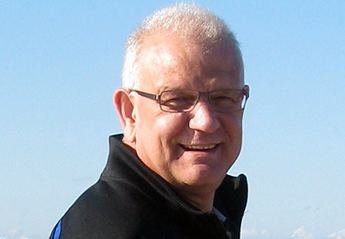Citizenship USA Nationality Belgium | Name Hugo Bellen | |
 | ||
Doctoral advisor John A. Kiger Jr. | ||
Hugo J. Bellen is a professor at Baylor College of Medicine and an investigator at the Howard Hughes Medical Institute who studies genetics and neurobiology in the model organism, Drosophila melanogaster, the fruit fly.
Contents

Education
Bellen obtained an MBA from the University of Brussels, a D.V.M. from the Department of Veterinary Medicine of Ghent University and a Ph.D. in Genetics from the University of California, Davis. He performed his postdoctoral studies in the laboratory of Walter J. Gehring at the Biozentrum in the University of Basel.
Neurodegeneration
Dr. Bellen’s current research focuses on an effort to decipher the mechanisms by which mutations in specific genes cause neurodegeneration, and to this end, he and his colleagues performed unbiased forward genetic screens in fruitflies that detect the progressive decline in function and morphology of photoreceptor neurons. To date over 165 genes that cause a neurodegenerative phenotype when mutated have been uncovered by Dr. Bellen’s group using this strategy. Many of these genes encode homologues of human genes that are known to cause neurodegenerative diseases, including Amyotrophic Lateral Sclerosis (ALS) (Lou Gehrig's disease), Charcot-Marie-Tooth (CMT), Parkinson’s disease (PD), Alzheimer’s disease (AD), Leigh syndrome, and others, and these studies will help provide a much better understanding of the molecular mechanisms by which neurodegeneration occurs. A prevailing theme among these mutants seems to be dysfunction of the neuronal mitochondria and an increasing inability to deal with oxidative stress, which manifests as lipid droplets.
Technology
Dr. Bellen has pioneered the development of novel technologies that accelerate Drosophila research and are currently used by the majority of fly labs today. Bellen was a leader in the development of P element-mediated enhancer detection which allows for discovery and manipulation of genes and was the impetus for a collaborative and ongoing project to generate an insertion collection for the community. Furthermore, Bellen and colleagues devised a new transformation technology that permits site-specific integration of very large DNA fragments, which led to the generation of a collection of flies carrying molecularly defined duplications for more than 90% of the Drosophila X-chromosome. Hundreds of Drosophila researchers utilize this collection. Most recently his lab created a new transposable element (MiMIC) that permits even more downstream manipulations via RMCE (recombinase-mediated cassette exchange), such as protein tagging and knockdown and large scale homologous recombination. His research constantly evolves with the changing technology to meet the needs of the Drosophila community.
Neurotransmitter release
Dr. Bellen has made numerous important contributions in the field of synaptic transmission in Drosophila. Through unbiased forward genetic screens designed to detect perturbations in neuronal function, he has uncovered many genes involved in synaptic transmission and has used reverse genetics to help to establish their function. His lab was the first to provide in vivo evidence that Synaptotagmin 1 functions as the main Calcium sensor in synaptic transmission and that Syntaxin-1A plays a critical role in synaptic vesicle (SV) fusion in vivo. His lab showed that Endophilin and Synaptojanin control uncoating of SVs, that the V0 component of the v-ATPase affects SV fusion, that synaptic mitochondria control SV dynamics, and in addition discovered a novel calcium channel involved in SV biogenesis. His pioneering work on synaptic vesicle trafficking molecules was later confirmed in the mouse.
Neuronal Development
Bellen and colleagues made important contributions to our understanding of Drosophila peripheral nervous system development and the fine-tuning of aspects of Notch signaling during this process. These discoveries were made by carrying out multiple forward genetic screens using the mutagen, ethyl methane sulfonate, as well as P elements. They discovered the protein Senseless that is required for the development of the peripheral nervous system by boosting the action of proneural proteins and suppressing the action of Enhancer of split proteins. They also discovered the protein Rumi and determined it was required for O-glycosylation of Notch at many different sites and that it these sites affect the cleavage of Notch at the membrane. Their research also uncovered a critical amino acid of the Notch protein that modulates its binding with Serrate. Finally, they helped elucidate the role of several other proteins in Notch signaling, including the role of Wasp/Arp2/3, Sec15, Tempura, and EHBP-1 in Delta processing and signaling.
